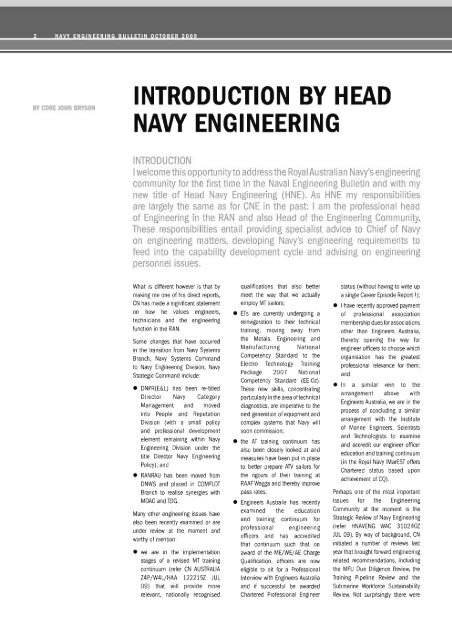ENGINE - Royal Australian Navy
ENGINE - Royal Australian Navy
ENGINE - Royal Australian Navy
Create successful ePaper yourself
Turn your PDF publications into a flip-book with our unique Google optimized e-Paper software.
BY CDRE JOHN BRYSON<br />
INTRODUCTION BY HEAD<br />
NAVY <strong>ENGINE</strong>ERING<br />
INTRODUCTION<br />
I welcome this opportunityto address the <strong>Royal</strong> <strong>Australian</strong> <strong>Navy</strong>'s engineering<br />
community for the first time in the Naval Engineering Bulletin and with my<br />
new title of Head <strong>Navy</strong> Engineering (HNE), As HNE my responsibilities<br />
are largely the same as for CNE in the past: I am the professional head<br />
of Engineering in the RAN and also Head of the Engineering Community,<br />
These responsibilities entail providing specialist advice to Chief of <strong>Navy</strong><br />
on engineering matters, developing <strong>Navy</strong>'s engineering requirements to<br />
feed into the capability development cycle and advising on engineering<br />
personnel issues,<br />
What is different however is that by<br />
making me one of his direct reports,<br />
CN has made a significant statement<br />
on how he values engineers,<br />
technicians and the engineering<br />
function in the RAN.<br />
Some changes that have occurred<br />
in the transition from <strong>Navy</strong> Systems<br />
Branch, <strong>Navy</strong> Systems Command<br />
to <strong>Navy</strong> Engineering Division, <strong>Navy</strong><br />
Strategic Command include:<br />
• DNPR(E&L) has been re-titled<br />
Director <strong>Navy</strong> Category<br />
Management and moved<br />
into People and Reputation<br />
Division (with a small policy<br />
and professional development<br />
element remaining within <strong>Navy</strong><br />
Engineering Division under the<br />
title Director <strong>Navy</strong> Engineering<br />
Policy); and<br />
• RANRAU has been moved from<br />
DNWS and placed in COMFLOT<br />
Branch to realise synergies with<br />
MOAC and TOG.<br />
Many other engineering issues have<br />
also been recently examined or are<br />
under review at the moment and<br />
worthy of mention:<br />
• we are in the implementation<br />
stages of a revised MT training<br />
continuum (refer CN AUSTRALIA<br />
Z4P/ W4L/ HAA 122215Z JUL<br />
09) that will provide more<br />
relevant, nationally recognised<br />
qualifications that also better<br />
meet the way that we actually<br />
employ MT sailors;<br />
• ETs are currently undergoing a<br />
reinvigoration to their technical<br />
training, moving away from<br />
the Metals, Engineering and<br />
Manufacturing National<br />
Competency Standard to the<br />
Electro Technology Training<br />
Package 2007 National<br />
Competency Standard (EE-Oz).<br />
These new skills, concentrating<br />
particularly in the area oftechnical<br />
diagnostics, are imperative to the<br />
next generation of equipment and<br />
complex systems that <strong>Navy</strong> will<br />
soon commission;<br />
• the AT training continuum has<br />
also been closely looked at and<br />
measures have been put in place<br />
to better prepare ATV sailors for<br />
the rigours of their training at<br />
RAAF Wagga and thereby improve<br />
pass rates;<br />
• Engineers Australia has recently<br />
examined the education<br />
and training continuum for<br />
professional engineering<br />
officers and has accredited<br />
that continuum such that on<br />
award of the ME/WE/ AE Charge<br />
Qualification, officers are now<br />
eligible to sit for a Professional<br />
Interview with Engineers Australia<br />
and if successful be awarded<br />
Chartered Professional Engineer<br />
status (without having to write up<br />
a single Career Episode Report I);<br />
• I have recently approved payment<br />
of professional association<br />
membership dues for associations<br />
other than Engineers Australia,<br />
thereby opening the way for<br />
engineer officers to choose which<br />
organisation has the greatest<br />
professional relevance for them;<br />
and<br />
• In a similar vein to the<br />
arrangement above with<br />
Engineers Australia, we are in the<br />
process of concluding a similar<br />
arrangement with the Institute<br />
of Marine Engineers, Scientists<br />
and Technologists to examine<br />
and accredit our engineer officer<br />
education and training continuum<br />
(in the <strong>Royal</strong> <strong>Navy</strong> IMarEST offers<br />
Chartered status based upon<br />
achievement of CQ).<br />
Perhaps one of the most important<br />
issues for the Engineering<br />
Community at the moment is the<br />
Strategic Review of <strong>Navy</strong> Engineering<br />
(refer HNAVENG WAC 310240Z<br />
JUL 09). By way of background, CN<br />
initiated a number of reviews last<br />
year that brought forward engineering<br />
related recommendations, including<br />
the MFU Due Diligence Review, the<br />
Training Pipeline Review and the<br />
Submarine Workforce Sustainability<br />
Review. Not surprisingly there were

















